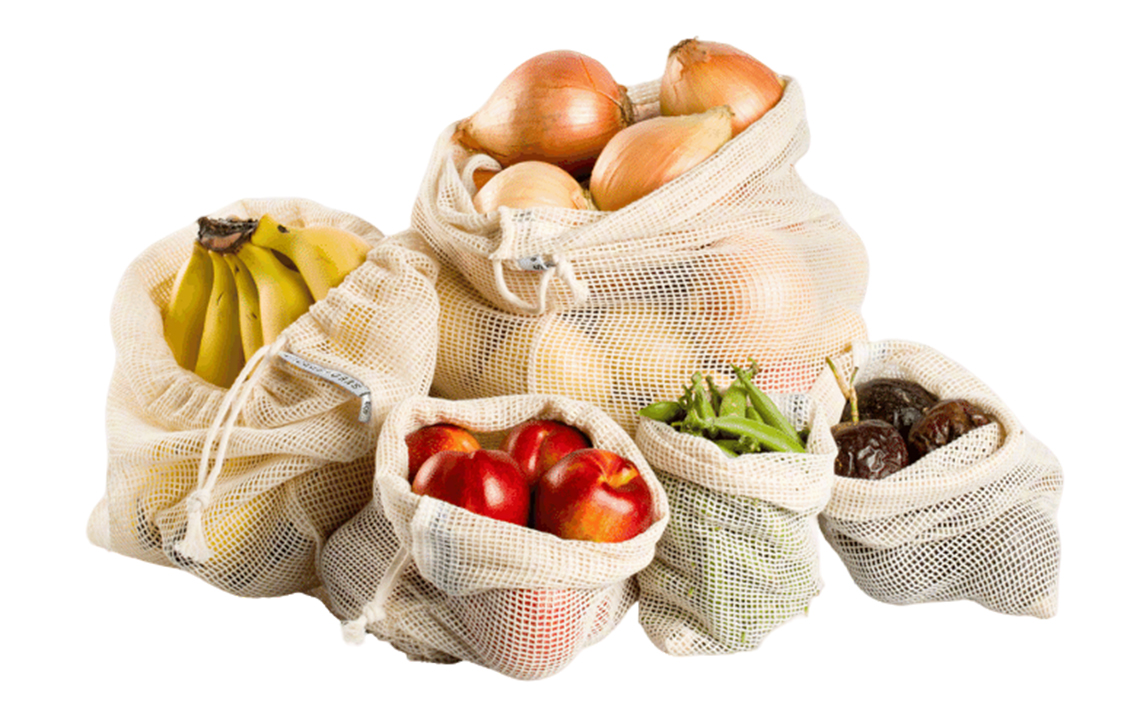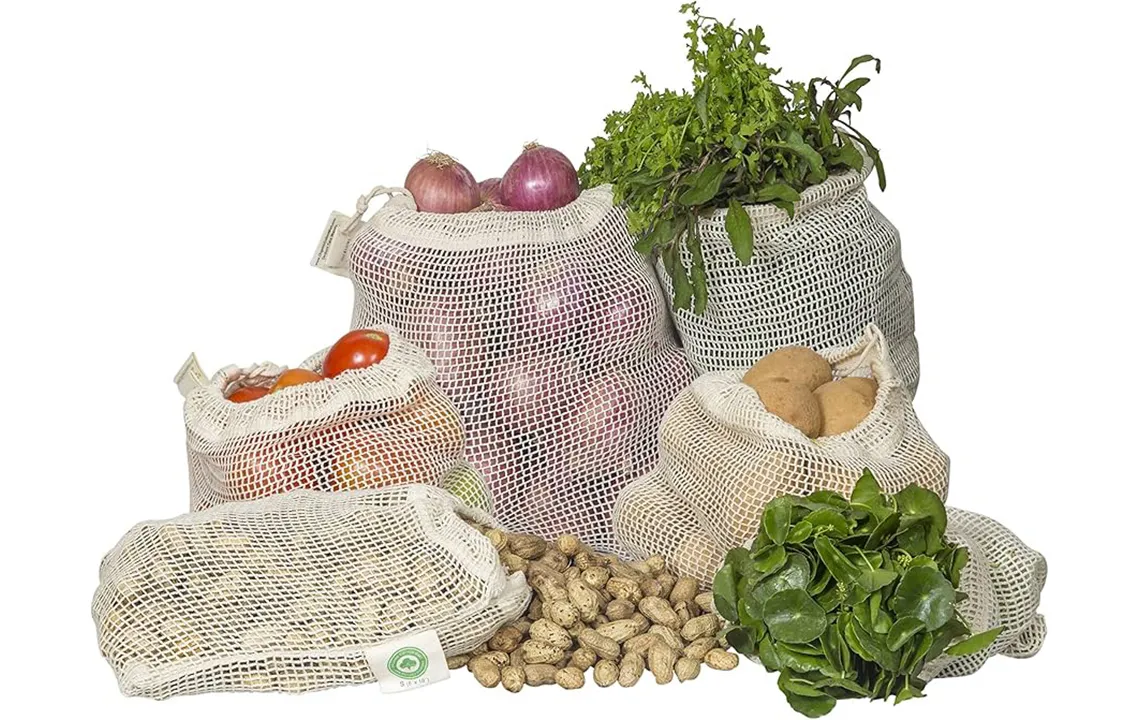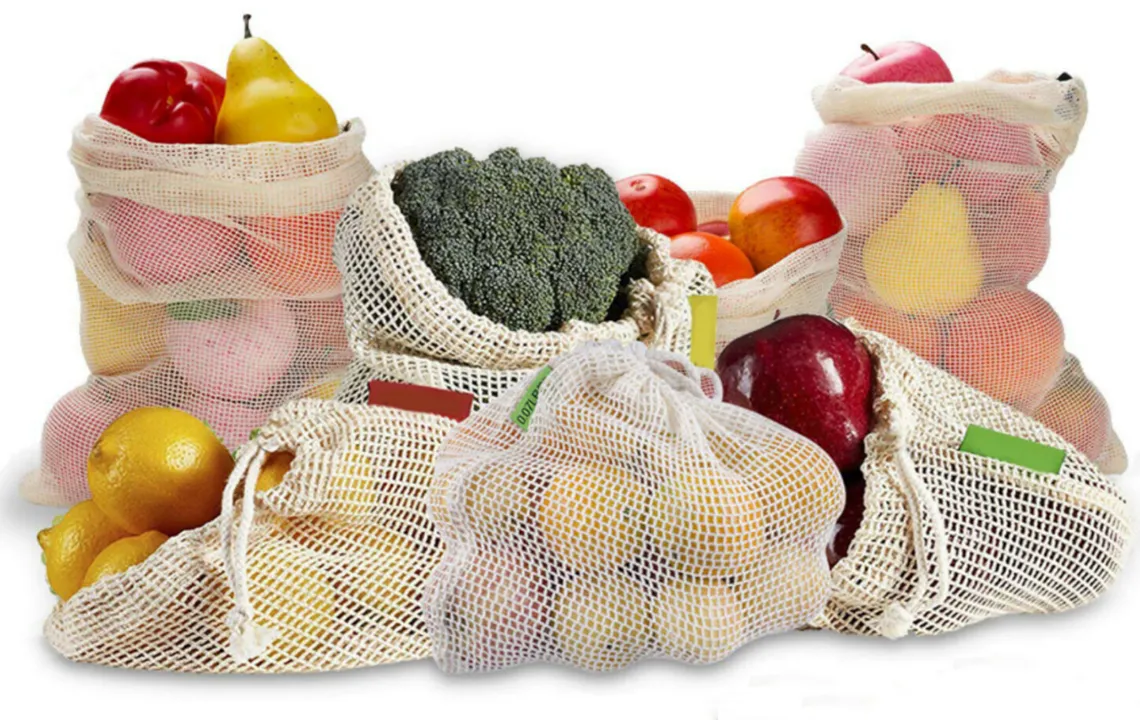Mesh bags allow vegetables to breathe, preventing moisture buildup, and can be washed and reused repeatedly. In this guide, we’ll explore when mesh bags are best and how to make the most of them in the kitchen.

Why storage matters
How you store vegetables makes a huge difference in how long they stay fresh, how good they taste, and even how much ends up in the trash. If you have ever opened your fridge to find wilted lettuce or carrots that turned soft and bendy, you know exactly what I mean. The truth is, vegetables are sensitive. Some like it cool and dry, some need a bit of airflow, and others last longer when kept in the fridge. Using the wrong method can turn crisp greens soggy almost overnight or cause sturdy root vegetables to sprout or rot before you even get a chance to use them.
That is where mesh bags come in handy. They are lightweight, breathable, and easy to reuse. For the right types of veggies, they can slow down spoilage and make your produce last longer. Still, they are not a magic solution for everything. Certain vegetables actually need more humidity or darkness than mesh bags can provide. Knowing which ones to keep in mesh and which ones to store another way makes all the difference between enjoying fresh food and wasting it.
What is a mesh bag?

Mesh bags are bags made from open weave fabric or netting. Common materials include cotton mesh nylon and recycled polyester. They come in small and large sizes and can be lightweight produce bags used at markets or heavier duty bags for storage at home.
Benefits of mesh bags for vegetables
- Better air circulation. The open weave lets air move around produce which reduces moisture buildup and mold.
- Visibility. You can see what is inside so you use items before they spoil.
- Reusable and washable. Many mesh bags can go in the washing machine on a gentle cycle.
- Lightweight and space saving. Mesh packs collapse and are easy to store when not in use.
- Good for rinsing. For items like berries or herbs you can rinse then let drain inside the mesh.
Limits and risks
- Not for cut or wet produce. Once vegetables are cut or very wet they need humidity control that mesh cannot provide.
- Some items prefer darkness. Potatoes and onions do better in darker spaces to slow sprouting.
- Dirt and bacteria can build up. If you do not wash bags regularly the mesh can harbor residue and off odors.
- Soft items can bruise. Overfilling a mesh bag or tossing heavy items into it can damage delicate produce.
- Material matters. Cheap synthetic mesh with residual chemicals can impart odor or affect taste for sensitive items.
Which vegetables work best in mesh bags
| Vegetable type | Examples | Why mesh helps |
|---|---|---|
| Firm root veg | Carrots beets turnips | Breathable mesh reduces mold and rot |
| Alliums | Onions garlic shallots | Air flow prevents moisture buildup and sprouting |
| Firm salad veg | Cucumber peppers | Keeps skin dry and crisp for longer |
| Leafy greens when dry | Kale cabbage lettuce | Good if leaves are dry before storing |
| Not recommended for long term | Tomatoes berries soft stone fruit | These bruise easily and need careful handling |
How to use mesh bags the right way
Follow these simple habits to get the most from mesh storage.
- Dry produce first. For leafy greens and washed items pat dry or spin in a salad spinner before putting in mesh. Excess water speeds rot.
- Do not overcrowd. Leave space for air to move. A loosely filled bag works better than one stuffed tight.
- Store in the right place. Put root vegetables in a cool dark spot. Keep salad greens in a refrigerator drawer if possible. Alliums do well in a dry pantry or cellar.
- Label with dates. Use a small tag or write on a sticker so you know when you stored the item.
- Rotate stock. Use older produce first. Visibility makes this easy.
- Wash bags regularly. Machine wash gentle or hand wash and air dry completely before reuse.
- Use separate bags for different types. Keep onions away from apples and potatoes if possible since some produce exchanges gases that speed spoilage.
Best materials and what to look for
- Natural cotton mesh. Breathable and gentle on produce. Choose organic cotton if you want to avoid chemical residues.
- Nylon or polyester mesh. Durable and dries quickly but check for food safe certification or low odor.
- Recycled polyester. A sustainable option if you prefer recycled materials.
- Stitch quality. Tight seams and reinforced edges last longer and prevent small bits from slipping out.
- Certifications. Look for OEKO TEX or similar to ensure the fabric is free from harmful substances.
Cleaning and care
- Machine wash on gentle cycle with mild detergent. Use cold water to protect fabric and color.
- Hand wash if you prefer. Soak in warm water with baking soda to remove odors and stains.
- Air dry fully. Do not store while damp.
- For stubborn smells soak in vinegar and water or baking soda paste then rinse.
- Replace when holes form or elastic and seams wear out.
When not to use mesh bags
- Cut fruit and vegetables that need to be kept dry under controlled humidity.
- Long term storage of potatoes in bright light.
- Highly perishable soft fruit intended for long transport.
- Any time you need a sealed or airtight environment.
Quick kitchen scenarios
- Market haul pick up. Use mesh bags for onions citrus apples and firm root vegetables. Keep berries in a separate ventilated container.
- Fridge storage for salad greens. Dry greens thoroughly then place in mesh bag inside the crisper drawer to help air flow.
- Short term countertop storage. Use mesh for onions garlic and potatoes but move to a cooler darker area for longer storage.
- Pre washed herbs. Dry herbs well then store in a mesh bag hung in the fridge to keep them crisp.
Alternatives and combos that work
- Paper bags. Good for onions and potatoes that need darkness and some breathability.
- Perforated plastic. Useful in the fridge for humidity control of some leafy items.
- Reusable silicone bags. Better for cut items and for airtight storage.
- Mesh plus paper. For some items place them in a paper bag then in mesh for additional protection while keeping airflow.
Conclusion
Mesh bags are a simple low cost tool to help keep many vegetables fresh longer. They work best for firm produce and items that benefit from air flow. Avoid using them for cut items or soft fruit meant for long storage. Keep bags clean dry and replace them when worn.
If you want food safe mesh bags or wholesale options for retail Contact us to request samples or get a quote. Try a few styles and sizes and see which fits your kitchen routine best.
FAQ
Can I wash my vegetables then store them in mesh right away?
You can but make sure to dry them well first. Excess moisture will speed up spoilage.
How often should I wash mesh bags?
A Wash after every few uses or immediately if a bag becomes soiled. For raw root veg you can wash weekly.
Will mesh bags reduce food waste?
They can help for many vegetables because better air flow reduces rot and mold. Proper use matters.
Can I freeze food in mesh bags?
Mesh is not ideal for freezing. Use freezer safe bags or containers for frozen storage.
Do mesh bags cause bruising?
Overfilled bags or rough handling can cause bruising. Use padded or fabric lined bags for delicate items.
Are mesh bags safe for baby food prep?
Use caution. If you are cleaning and preparing food for infants choose materials with food safety certification and wash thoroughly before use.

